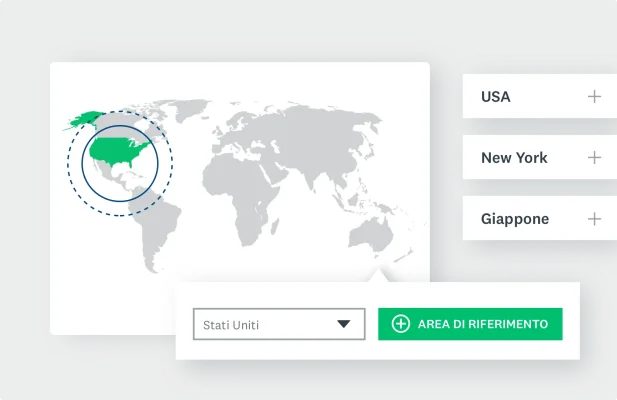5 metodi di segmentazione del mercato e come utilizzarli (con esempi)

- La segmentazione del mercato consiste nella suddivisione di un ampio numero di consumatori in gruppi più piccoli, distinti sulla base di caratteristiche comuni.
- Segmentare il mercato è fondamentale perché consente alle aziende di rivolgersi a gruppi specifici di consumatori con più efficacia, ottenendo una maggiore soddisfazione dei clienti e un miglioramento del rendimento aziendale complessivo.
- Mostreremo cinque diverse modalità di segmentazione del mercato, ovvero la segmentazione demografica, psicografica, comportamentale, geografica e firmografica.
Immagina i tuoi clienti come un vivace mosaico composto da una moltitudine di elementi unici, accomunati da alcuni tratti di somiglianza. La segmentazione del mercato consiste nell'arte di riconoscere queste somiglianze, di raggruppare i clienti in base ai loro tratti comuni e di elaborare strategie che rispondano alle loro esigenze e ai loro desideri collettivi.
Una volta definiti questi gruppi, le aziende possono promuovere in modo più efficace i loro prodotti o servizi ai vari segmenti di clientela. Ognuno di essi può avere determinate preferenze che lo contraddistinguono. Concentrandosi sui desideri e le preferenze di ciascun gruppo, le aziende possono migliorare il coinvolgimento, incrementare le interazioni e stimolare le vendite.
Che cosa si intende per segmentazione del mercato?
Per segmentazione del mercato si intende il processo di suddivisione di una vasta popolazione in sottogruppi sulla base di fattori condivisi. Questi gruppi possono presentare tratti demografici comuni (età, genere, ecc.), vivere nella stessa area geografica o avere atteggiamenti, comportamenti e altre caratteristiche simili.
La creazione di gruppi più piccoli basati su fattori comuni permette di calibrare meglio la comunicazione con il pubblico.
Conosci le caratteristiche del tuo mercato di riferimento?
Scoprile in pochi minuti con la Segmentazione dei consumatori di SurveyMonkey.
Perché usare la segmentazione nel marketing
Mediante la segmentazione del mercato le aziende possono sviluppare profili specifici per ciascun segmento. Una volta definiti chiaramente questi profili, i marketer selezionano i segmenti con il più alto potenziale di acquisto dei loro prodotti e servizi.
Per arrivare a questo risultato, è necessario intraprendere una procedura in tre fasi che chiarisce chi sono le persone di ogni segmento e perché acquistano i prodotti.
- Segmentazione: gli esperti di marketing dividono i consumatori in categorie in base a tratti condivisi.
- Targetizzazione: viene selezionato il pubblico di destinazione, detto target, ovvero il gruppo di consumatori più propenso ad acquistare i prodotti.
- Posizionamento: i marketer analizzano le combinazioni di prodotti, prezzi, promozioni e luoghi con maggiori probabilità di indurre i clienti ad acquistare i prodotti.
Una volta identificato il pubblico di destinazione, i marketer dovranno evidenziare ciò che differenzia il loro prodotto. È migliore, più veloce, più economico o più tecnologicamente avanzato rispetto a quelli della concorrenza? Per rispondere a questa domanda, è necessario capire quali sono i problemi del pubblico di destinazione e come è possibile risolverli in modo creativo.
Le aziende guadagnano un vantaggio competitivo mediante la differenziazione dei loro prodotti, ovvero facendo in modo che si distinguano come soluzione perfetta ai problemi degli acquirenti.
Identificando un mercato di riferimento, isolando i suoi problemi e creando un prodotto che li risolva, gli esperti di marketing hanno maggiori probabilità di successo rispetto ai loro concorrenti.
Esempi di segmentazione del mercato
La segmentazione del mercato è il primo passo per una campagna marketing di successo. Sia che le aziende rivolgano le loro campagne a consumatori o ad altre aziende, i segmenti di mercato aiutano a comprendere meglio i problemi dei loro clienti e a risolverli.
Non tutte le aziende segmentano i loro clienti allo stesso modo. Esistono approcci diversi alla segmentazione.
Analizziamo tre tra gli approcci più comuni.
Nessuna segmentazione
Le aziende si affidano al marketing di massa per vendere i loro prodotti a chiunque, seguendo una strategia indifferenziata. Ad esempio, per prodotti come il sale o altri articoli generici con numerosi sostituti non vale la pena fare studi di segmentazione del mercato.
Segmentazione limitata
Le aziende possono usare uno o più mercati di riferimento definiti in modo ristretto per identificare un preciso mercato di nicchia per prodotti specializzati, come abbigliamento esclusivo d'alta moda, manufatti artistici o componenti di macchinari personalizzati.
Iper-segmentazione
Questo approccio viene utilizzato per definire strategie di marketing su misura per ogni singolo cliente, allo scopo di sviluppare relazioni durature. Tra gli esempi vi sono i servizi personalizzati offerti dai parrucchieri o i consigli mirati di retailer online come Amazon, scelti in base alla cronologia di acquisto del cliente.
5 metodi di segmentazione del mercato
Indipendentemente dal numero di segmenti che si desidera delineare, ogni azienda dovrebbe conoscere i cinque principali tipi di segmentazione del mercato.
Analizziamo le segmentazioni demografica, psicografica, comportamentale, geografica e firmografica, cosa prevedono e come utilizzarle.
1. Segmentazione demografica
La segmentazione demografica presuppone che le persone con caratteristiche comuni abbiano stili di vita, gusti e interessi comuni che andranno a influenzare le loro abitudini di acquisto. Questo tipo di segmentazione viene spesso combinata ad altri approcci, per definire mercati di riferimento con le migliori probabilità di acquisto dei prodotti.
Le caratteristiche demografiche includono fattori quali età, genere, occupazione, reddito e istruzione.
Come usare la segmentazione demografica
Il principale vantaggio della segmentazione demografica è che è facile da rilevare. Fonti pubbliche o governative, come l'Istituto Nazionale di Statistica (Istat) in Italia, forniscono dati su nucleo familiare, reddito, istruzione e salute, utili per definire la strategia di marketing e gli obiettivi aziendali.
Dopo aver utilizzato i dati demografici per la segmentazione del mercato, i marketer possono servirsi delle stesse informazioni per la segmentazione dei clienti. Utilizzando dati demografici e sul comportamento, è possibile identificare:
- Quanto è grande l'opportunità di mercato per il prodotto
- Come si posiziona il marchio rispetto alla concorrenza
- Quali fasce demografiche della popolazione hanno maggiori probabilità di acquistare il prodotto o servizio
- Quali campagne pubblicitarie avranno maggiore presa sul mercato di riferimento
Se combinata con tratti comportamentali e altre variabili, la segmentazione demografica fornisce preziose informazioni per capire quali specifici clienti all'interno del mercato di riferimento acquisteranno i prodotti e come raggiungerli con i giusti messaggi di marketing.
2. Segmentazione psicografica
La segmentazione psicografica divide le persone in gruppi in base a personalità, stile di vita, stato sociale, attività, interessi, opinioni e atteggiamenti. La segmentazione psicografica si combina alla perfezione con quella demografica in quanto entrambe identificano le motivazioni alla base di particolari scelte delle persone.
Hai controllato i dati demografici del tuo mercato di riferimento ultimamente?
Le cose cambiano in fretta. Ricalibra i tuoi parametri con la Segmentazione dei consumatori di SurveyMonkey.
Come usare la segmentazione psicografica
La segmentazione psicografica è un metodo estremamente efficace per comprendere i problemi, i comportamenti e gli atteggiamenti dei clienti.
Segmentando il mercato in base a caratteristiche psicografiche è possibile capire:
- Come i consumatori percepiscono i prodotti e servizi
- Cosa vogliono veramente i consumatori e perché
- Lacune o punti deboli dei prodotti o servizi attuali
- Opportunità di coinvolgimento futuro
- Come raggiungere in modo efficace il pubblico di destinazione
3. Segmentazione comportamentale
La segmentazione del mercato di tipo comportamentale descrive passaggi specifici del processo di acquisto del cliente ideale: cosa desidera, perché, quali vantaggi punta a ottenere e in che modo cerca di soddisfare le proprie esigenze.
Come usare la segmentazione comportamentale
Questo tipo di segmentazione viene utilizzato per studiare i segmenti di mercato B2C e B2B. Se le aziende capiscono che cosa spinge le persone ad acquistare, possono focalizzare meglio i loro messaggi di marketing. I dati comportamentali possono includere:
- Motivo dell'acquisto. Gli acquirenti sono attirati da prezzi allettanti, ottime recensioni, considerazioni di sicurezza o altro?
- Occasione o evento. I consumatori fanno acquisti in occasione di festività o date particolari? Gli acquirenti B2B cercano di usare tutto il budget a loro disposizione prima della fine dell'anno?
- Vantaggi del prodotto. Gli acquirenti sono alla ricerca della tecnologia più recente, del prodotto più sicuro o vogliono essere i primi ad avere l'ultima novità del mercato?
- Fase del percorso dell'acquirente. L'acquirente cerca informazioni per un futuro acquisto? O vuole provare il brand per la prima volta?
- Livello di coinvolgimento. L'acquirente è già fedele al marchio e sta cercando il prodotto più recente?
Scoprendo perché consumatori e aziende acquistano i loro prodotti, i professionisti del marketing possono adattare le loro strategie di segmentazione a tali motivazioni.
4. Segmentazione geografica
La segmentazione geografica consente agli esperti di marketing di raggruppare le persone in base a dove vivono, lavorano o viaggiano.
La posizione geografica influenza in modo importante le abitudini di acquisto e i marketer possono sviluppare messaggi pubblicitari tenendo conto di tali informazioni. Le variabili di segmentazione geografica utilizzate dai marketer sono diverse e possono includere il paese, la regione, lo stato, la provincia, la città, la zona climatica o il codice postale.
Anche cultura e densità della popolazione (area urbana o rurale) sono dati cruciali da includere nelle ricerche di mercato. Queste variabili relative ai luoghi determinano le tipologie di problemi che chi vive in determinate aree si trova ad affrontare e il modo in cui possono essere risolti.

Come usare la segmentazione geografica
Il luogo in cui una persona vive può influenzare tutto, dalle scelte alimentari all'auto che guida. Le aziende possono utilizzare la segmentazione geografica per determinare i prodotti migliori da vendere ai propri clienti.
Un esempio dell'uso della segmentazione geografica è rappresentato dalla commercializzazione delle piante in base alla zona climatica. I gerani saranno maggiormente pubblicizzati in località calde e soleggiate, mentre l'abete del Colorado sarà destinato a luoghi con inverni rigidi. Conoscere i dettagli dell'area geografica permette ai marketer di identificare le piante, i terricci e gli accessori da giardino che meglio si venderanno in ciascuna zona climatica.
Oppure, un'azienda di abbigliamento potrebbe consigliare un capospalla alle persone che vivono nelle zone più fredde. Adattare i prodotti pubblicizzati ai clienti in base alla loro posizione può cambiare radicalmente il loro modo di considerare l'acquisto.
Altre risorse: Guida completa all'uso delle indagini per la segmentazione
5. Segmentazione firmografica
La segmentazione firmografica (ovvero relativa alla demografia d'impresa) rappresenta per i marketer B2B ciò che la segmentazione demografica è per i marketer B2C. I dati firmografici definiscono le caratteristiche del mercato business di riferimento in termini di settore, numero di dipendenti, natura giuridica, dimensioni dell'azienda, posizione finanziaria e altre variabili commerciali.
Milioni di persone si spostano ogni anno. I profili geografici del tuo mercato di riferimento sono cambiati? Scoprilo nel giro di poche ore con la Segmentazione dei consumatori di SurveyMonkey.
Come usare la segmentazione firmografica
La segmentazione firmografica offre ai marketer informazioni su punti di forza e vitalità delle aziende del proprio mercato di riferimento. Concentrandosi su prestazioni finanziarie e tendenze di crescita, riescono a capire se il segmento di mercato è in fase di espansione o contrazione.
Esempi di dati firmografici:
- Classificazione di settore - Codice ATECO di classificazione delle attività economiche.
- Proprietà e stato giuridico - Regime di proprietà, come impresa individuale, società a responsabilità limitata (SRL), partnership a responsabilità limitata, imprese private ed enti pubblici.
- Anni di attività - Gli anni di attività possono essere un indicatore di solidità finanziaria ed esperienza nel settore.
- Numero di dipendenti - Il numero di dipendenti è indice delle dimensioni dell'azienda.
- Sede - Per sede si possono intendere uffici, stabilimenti o punti vendita.
- Clienti e prodotti - Quali sono i prodotti realizzati o commercializzati dall'azienda e qual è il suo pubblico di destinazione.
- Dimensioni del mercato - Quali sono le dimensioni del mercato dell'azienda e quali sono i suoi concorrenti.
I vantaggi della segmentazione del mercato

La segmentazione del mercato è alla base di prodotti vincenti, lanci di successo e della buona riuscita di campagne marketing e pubblicitarie, così come di altre importanti attività di marketing.
Le aziende investono risorse importanti nell'analisi dei problemi dei propri clienti tipo, per poterli risolvere offrendo prodotti e servizi di valore. Quali vantaggi traggono le aziende dall'investimento di tempo e risorse nella segmentazione del mercato?
Campagne pubblicitarie migliori
Una volta identificato il proprio pubblico e ciò di cui ha bisogno, le aziende investono ingenti somme in marketing e pubblicità. I marketer acquisiscono enormi quantità di dati sul pubblico di destinazione per assicurarsi che i loro messaggi vadano a segno e raggiungano la persona giusta, al momento giusto, per il prodotto giusto.
I sondaggi sono un ottimo strumento di indagine per testare i messaggi di marketing e vedere se piacciono al pubblico di destinazione. I ricercatori formulano un'ipotesi su quale pensano sarà la reazione dei rispondenti. I risultati dell'indagine li aiuteranno a creare messaggi migliori e campagne più mirate.
Sviluppo di prodotti mirati
Le aziende hanno spesso grandi idee per i nuovi prodotti, ma devono in primo luogo determinare se tali idee possono risolvere i problemi del loro pubblico di destinazione. Senza la segmentazione del mercato, rischierebbero di sprecare tempo e denaro in prodotti che sembrano buoni, ma non vendono.
Le indagini aiutano a tastare il polso del mercato di riferimento. In poche ore, le aziende possono scoprire se:
- Stanno risolvendo un problema del loro mercato di riferimento.
- Una o più delle loro idee è chiaramente vincente.
- Il concept di prodotto ha le caratteristiche, la confezione e il logo giusti.
- I consumatori acquisteranno il prodotto e a quale prezzo.
Ottenere le risposte giuste da un mercato di riferimento accuratamente definito aiuta le aziende a concentrarsi su prodotti che il pubblico è disposto ad acquistare.
La soluzione di verifica dei concetti di SurveyMonkey è in grado di dirti se l'idea del tuo nuovo prodotto sarà vincente. Puoi ottenere una scheda di valutazione delle prestazioni con parametri di riferimento del settore.
Identificazione di nuove tendenze e opportunità
Le tendenze cambiano rapidamente. I social media possono fornire informazioni sui nuovi comportamenti dei clienti, tuttavia i marketer non possono sapere se le opportunità sono effettivamente realizzabili senza misurare tali comportamenti.
Comprendere il comportamento di un mercato di riferimento è l'essenza della segmentazione del mercato. Quando iniziano a prendere piede delle nuove tendenze, tocca ai marketer scoprire quali tra esse rappresentano realmente delle nuove opportunità di profitto e quali saranno presto dimenticate.
I marketer sono responsabili di identificare i problemi emergenti dei clienti, definire nuovi messaggi commerciali e testare nuovi concept di prodotto. Per individuare nuove opportunità, essi devono sottoporre regolarmente a indagine il loro pubblico di riferimento, allo scopo di ottenere nuove informazioni e verificare se i prodotti esistenti continuano a essere apprezzati.
Miglioramento delle operazioni aziendali
La segmentazione del mercato fornisce una serie di dati affidabili, incluse informazioni sui clienti che gli altri reparti possono utilizzare per contribuire ai risultati dell'azienda. Nelle aziende B2B, i reparti marketing e vendite sono spesso strettamente collegati, infatti le vendite dipendono dal marketing per generare lead qualificati che portino a maggiori ricavi.
Il reparto incaricato di definire i prezzi impiega i dati relativi al mercato e alla concorrenza per applicare i prezzi corretti e mantenere un vantaggio competitivo. Infine, per evitare di organizzare turni straordinari per un improvviso incremento della domanda, è fondamentale che il reparto produttivo abbia accesso ai dati sulle tendenze di acquisto, al fine di mantenere la produzione sempre al passo.
La segmentazione del mercato non è dunque destinata esclusivamente a finalità di marketing. I dati dovrebbero essere condivisi a livello di intera organizzazione per offrire ai clienti un servizio migliore.
Rafforzamento del "brand trust", la fiducia nel marchio
Alle aziende non basta vendere al proprio pubblico di destinazione. Esse vogliono stabilire rapporti duraturi con i clienti in modo che continuino ad acquistare i loro prodotti. Quando i clienti imparano a conoscere, apprezzare e comprare in modo continuativo i prodotti di un'azienda, significa che si è creata fiducia nel marchio.
La segmentazione del mercato aiuta a identificare il tipo di pubblico che acquisterà i prodotti di un'azienda non una sola volta, ma con continuità nel tempo. Creando un'identità del marchio apprezzata dai clienti, la notorietà del brand si rafforza e l'azienda arriva a instaurare un rapporto consolidato con il proprio pubblico di destinazione. Rimanendo focalizzate su tale rapporto di fiducia, le aziende creano messaggi di marketing, nuovi prodotti e contenuti a valore aggiunto che contribuiscono a migliorare la customer experience e a fare in modo che consumatori e clienti B2B ritornino per acquisti futuri.
La segmentazione del mercato di riferimento aiuta i marketer a capire i problemi e i comportamenti dei loro clienti ideali, per realizzare soluzioni finalizzate a instaurare rapporti di fiducia a lungo termine e che andranno ad avvantaggiare entrambe le parti.
Che tipo di rapporto hai con il tuo pubblico?
Scopri come rafforzare la fedeltà al tuo brand con il Monitoraggio del marchio di SurveyMonkey.
Segmenta i tuoi dati con SurveyMonkey
Comprendere la segmentazione del mercato permette alle aziende di creare contenuti più coinvolgenti e personalizzati in grado di fare presa su tutti i clienti. La segmentazione del pubblico è fondamentale per distribuire messaggi di marketing efficaci e aumentare il coinvolgimento della clientela.
Scopri di più su come segmentare i tuoi dati con SurveyMonkey, creando gruppi di clienti specifici per comunicazioni aziendali altamente efficaci. Registrati oggi stesso per iniziare con la segmentazione del mercato.
Inizia la tua ricerca di mercato
Panel d'indagine globale
Raccogli dati di ricerca di mercato inviando la tua indagine a un campione rappresentativo
Soluzioni avanzate
Testa le idee pubblicitarie o i concept di prodotti utilizzando un approccio di analisi e reporting automatizzato
